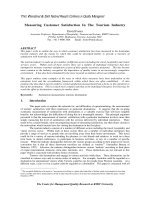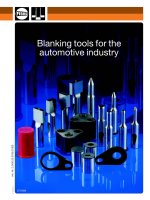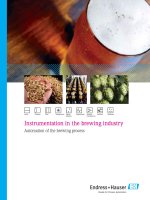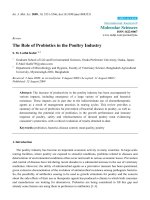Fuel Cells in the Automotive Industry
Bạn đang xem bản rút gọn của tài liệu. Xem và tải ngay bản đầy đủ của tài liệu tại đây (1.57 MB, 13 trang )
WHITE PAPER ON CHEMICAL ENGINEERING
Fuel Cells in the
Automotive Industry
©
COPYRIGHT 1994 - 2001
by
COMSOL AB
. All rights reserved.
by
Ed Fontes
EvaNilsson
CHEMICAL ENGINEERING IN THE AUTOMOTIVE INDUSTRY
3
Fuel Cells in the
Automotive Industry
The design of catalyst reactors has made the car engine substantially cleaner during the
last two decades. Car manufacturers have applied large efforts in reducing the emissions
of hazardous gases from the combustion engine. However, it has still proven to be
difficult to eliminate NOx and SOx emissions from this process.
The chemical energy of gasoline is converted to mechanical energy via the production
of heat in the combustion process of conventional car engines. The efficiency of this
process is limited by the efficiency formula for the Carnot cycle. A more efficient
process, and one of the main candidates for power production in future cars, is the new
generation of fuel cells. These work principally as batteries do, yet while batteries can be
considered as batch reactors, fuel cells are continuous reactors. In a fuel cell-powered
engine, the chemical energy in the fuel is converted to electrical energy, and then to
mechanical energy by an electric motor. The process by-passes the limitations of the
Carnot cycle, and the theoretical efficiency is substantially higher than that for the
combustion engine. This implies that a fuel cell-powered car will be able to run for
longer distances using the same amount of fuel compared to a conventional car. Carbon
dioxide emissions are consequently lowered, since smaller amounts of fuel are consumed
for the same distance traveled. The low temperatures in the process practically eliminate
the production of NOx and SOx.
The development of fuel cell powered-vehicles has accelerated during the last five
years. Competition between the different players is growing and the fight for a share of a
potentially huge market has already started. Technological development is one of the
most important weapons at this early stage, and small companies with technical skills in
the field of fuel cell processes have become important partners to the large automotive
companies.
Mathematical modeling is one important tool in the development of fuel cell systems.
A combination of modeling and experiments has shown to lower costs and accelerate the
pace of building prototypes and understanding of these new systems. The optimization
of the fuel cell, in combination with the auxiliary equipment and the operation of the
electrical motor, requires a lot of mathematical puzzling.
Advancement in the area of computing has implied that simulations that required
super computers just a few years ago can today be run on workstations or even PCs. This
has made computer simulations available to a much larger number of engineers.
In this paper, we will look at the fuel cell system through a gallery of mathematical
models, and particularly at models of the electrochemistry in the fuel cell itself. We will
CHEMICAL ENGINEERING IN THE AUTOMOTIVE INDUSTRY
4
look at the processes as they take place in the heart of the fuel cell system, i.e. in the
electrodes and electrolyte in the fuel cell stack. These processes are studied at a micro
level, where single catalyst agglomerates are modeled, as well as on the level of a unit cell
consisting of an anode, a cathode and the electrolyte in between them. We will also look
at reactor models of the reformer and the catalytic burner in the fuel processor. Finally,
we will study the design of the bipolar plates and their influence on the ohmic losses in
the fuel cell stack.
All of the models shown in the figures throughout the paper have been produced by
the finite element package, Femlab. One of Femlab’s strongest features is that we can
define arbitrary nonlinear systems of partial differential equations and fully couple them.
This makes Femlab extremely powerful in handling the nonlinearities that arise when we
model reactors and when we treat the kinetics at the fuel cell electrodes.
The fuel cell system
The fuel cell system can be simply structured into the following components: a fuel
processor, an air system, a fuel cell stack and a water and heat management system.
Figure 1 shows a simplified flow chart of the system.
Figure 1. Simplified flow chart of the fuel cell system.
CHEMICAL ENGINEERING IN THE AUTOMOTIVE INDUSTRY
5
The fuel, methanol in the case of figure 1, enters the fuel processor where it is converted
into hydrogen. The produced hydrogen reformate is cleaned from by-products that are
hazardous for fuel cell catalysts, like carbon monoxide, in a clean-up system. The cleaned
and moisturized hydrogen-rich reformate is run to the fuel cell’s anode chambers where
the hydrogen is oxidized while oxygen is reduced at the cathode. Water is used to
moisturize hydrogen, since water is transported from the anode to the cathode by
electro-osmosis. Air is supplied to the cell via a compressor. The compressed cathode
chamber exhaust is run through an expander, in order to win back some of the energy
from the compression step. Air is also supplied to the fuel cell processor. The DC-
current produced in the process is transferred to a power conditioner before it is supp-
lied to the electric motor. The spent fuel which still contains some hydrogen, is fed to a
catalytic burner and the heat produced in this combustion process is used in the fuel
processor.
The Fuel Processor and Auxiliary System
The optimal fuel in a fuel cell, from the environmental point of view, is hydrogen
produced by means of renewable sources, such as solar power. However, hydrogen is still
difficult to store in an efficient way, despite extensive research being put into using metal
hydrides and nano fibers.
The storage of hydrogen in alcohols and hydrocarbons is the most effective storage
available today. For automotive applications, hydrogen can be stored efficiently in
methanol. Methanol can be reformed into hydrogen in an external reformer, which is in
essence a tubular reactor. This reformation can be obtained through steam reforming
or partial oxidation
Partial oxidation offers quick start up and, since it is an exothermic reaction, requires
heat dissipation. Steam reforming has a higher rate of conversion, but is a slower process
and, since it is an endothermic reaction, requires heat being supplied to the system. A
combination of both reactions is obtained in the auto-thermal reactor, in which the
reformation reaction gets its heat from the partial oxidation reaction.
The design of the reformer is important for the performance and efficiency of the
total system. It should be able to work at low and high loads, and at high sudden
outputs, e.g., when the car is accelerated. The weight and space taken up by the reactors
should be minimized, and the heat management system optimized for different
operating conditions.
CHEMICAL ENGINEERING IN THE AUTOMOTIVE INDUSTRY
6
Figure 2 shows the temperature distribution in a tubular reactor for reformation of
methanol to hydrogen through the steam reforming reaction. We can see from this
figure that a jacket heats the reformer while the reactions in the reactor core consume
heat. The curved surfaces in the core represent isothermal surfaces. Different color
scales are used for the heating jacket and for the core, since temperature differences are
significantly larger in the core. The heat is exchanged from the heating channels in the
jacket, through the highly conductive jacket material, and into the core. We can
calculate the temperature profile by defining a heat balance in the reactor, assuming
that heat transfer takes place by conduction and convection.
Figure 2. Simulated temperature profile in the heating jacket and in the core of a steam reforming
reactor.
The hydrogen-rich reformate is supplied to the fuel cell where hydrogen is consumed.
However, to avoid build up of by-products from the processor, and to optimize the
operation of the cell, a surplus of fuel is usually fed to the cell. The exhaust from the
cell is therefore supplied to a catalytic burner and the heat produced in the combustion
process is subsequently used in the fuel processor. The advantage of using a catalytic
burner is that the combustion process takes place at a low temperature thus
minimizing the production of NOx. The catalytic burner might consist of a packed bed
of sintered palladium catalysts.
Figure 3 shows the simulated reaction distribution in a catalytic burner. We can
obtain the flow distribution by combining the mass balance with Darcy’s law for flow
through porous media. In this case, we assume that one of the burner walls
accidentally became too thin in the manufacturing process, which results in a non-
uniform flow distribution through the porous catalyst and a non-uniform combustion.
In figure 3, the red color signifies areas of higher combustion rate due to a larger
convective flow of fuel. This might eventually lead to a non-uniform temperature
distribution, and eventually ignition of the gas stream.









